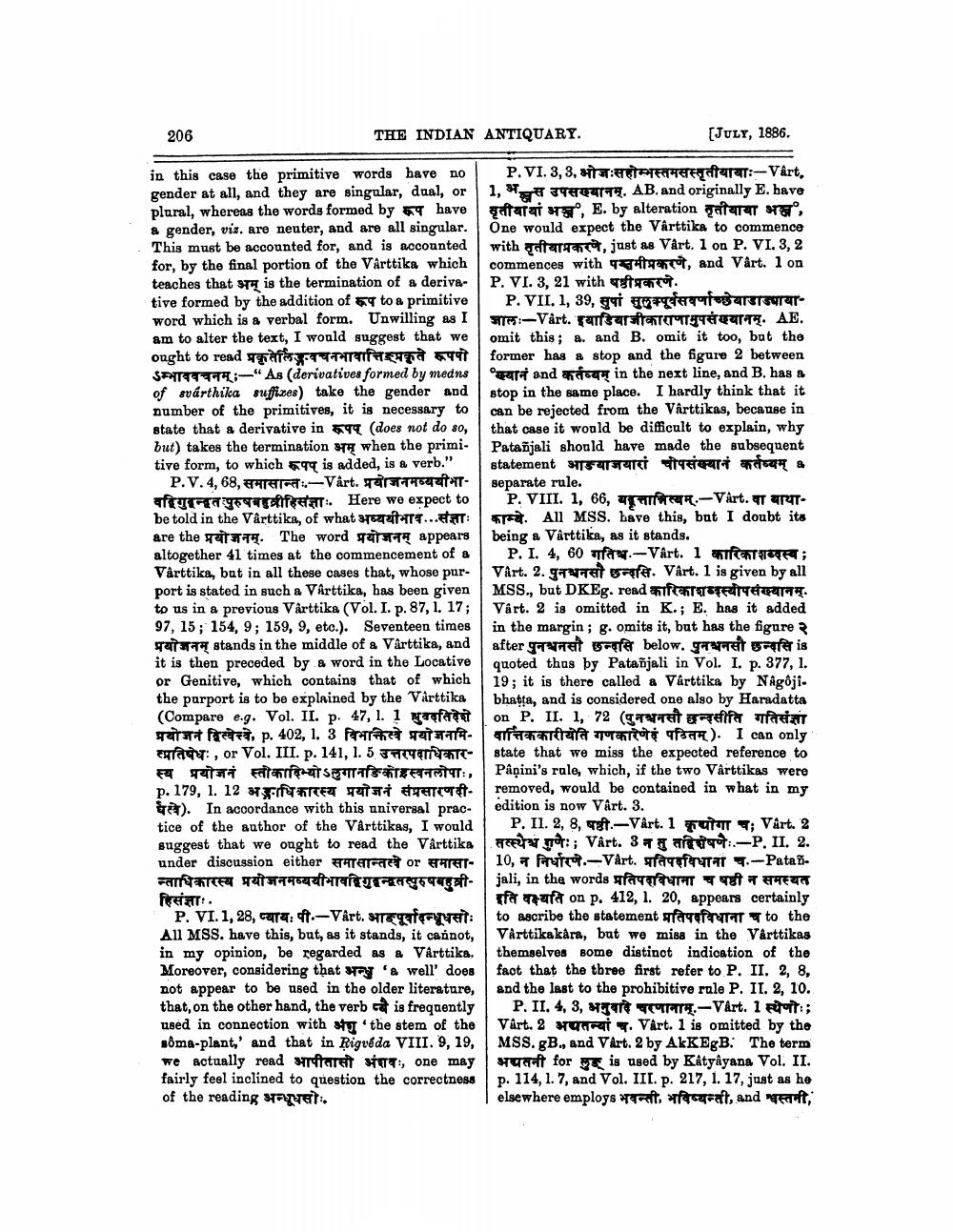________________
206
THE INDIAN ANTIQUARY.
(JULY, 1886.
in this case the primitive words have no P. VI. 3, 3, T UTTE T art:-Vârt, gender at all, and they are singular, dual, or 1, 3 04r74. AB. and originally E. bave plural, whereas the words formed by 59 have तृतीबायां भञ्ज', E. by alteration तृतीयाया अख', & gender, vis. are neuter, and are all singular. One would expect the Vårttika to commence This must be accounted for, and is accounted with our art, just as Vårt. 1 on P. VI. 3,2 for, by the final portion of the Vårttika which commences with you , and Vårt. 1 on teaches that st is the termination of a deriva- P. VI. 3, 21 with att tive formed by the addition of 59 to a primitive P. VII, 1, 39, gi litteraturster word which is a verbal form. Unwilling as I - Vårt. TarfurstenT TOITETTUTTE. AE. am to alter the text, I would suggest that we omit this; a. and B. omit it too, but the onght to read
tre ia 5991 former has a stop and the figure 2 between SFTTTT:"As (derivatives formed by medns art and are in the next line, and B. has & of svarthika suffixes) take the gender and stop in the same place. I hardly think that it number of the primitives, it is necessary to can be rejected from the Virttikas, because in state that a derivative in 5.99 (does not do 80, that case it would be difficult to explain, why but) takes the termination se when the primi.
Patañjali should have made the subsequent tive form, to which 599 is added, is a verb." statement rai T
& P.V.4, 68, ATS -Vârt. 642 IT- separate rule. वद्विगुबन्त पुरुषबहुव्रीहिसंज्ञाः. Here we expect to P. VIII. 1, 66, f .-Vart. T IT. be told in the Vârttika, of what storzított... ERST: a. All MSS. Lave this, but I doubt its are the प्रयोजनम्. The word प्रयोजनम् appears being a Vârttika, as it stands. altogether 41 times at the commencement of a P. I. 4, 60 a.-Vârt. 1 ETTER; Vårttika, but in all these cases that, whose pur. Vårt. 2. TINTE irer. Vårt. 1 is given by all port is stated in such a VArttika, has been given MSS., but DKEg. read after TETETT . to us in a previous Vårttika (Vol. I. p. 87, 1, 17; Vårt. 2 is omitted in K.; E. has it added 97, 15; 154, 9; 159, 9, etc.). Seventeen times in the margin; g. omits it, but has the figure प्रयोजनम् stands in the middle of a Varttika, and | after पुनश्चनसौ छन्दसि below. पुनश्चनसौ छन्दसि is it is then preceded by a word in the Locative quoted thus by Patañjali in Vol. I. p. 377, 1. or Genitive, which contains that of which 19; it is there called a Várttika by Nagôji. the purport is to be explained by the Värttika bhatta, and is considered one also by Haradatta (Compare e.g. Vol. II. p. 47, 1. 1 aaaa on P. II. 1, 72 (grate THE Ut fact, p. 402, 1, 3 PTT TA a rrara Tra fa). I can only curadu, or Vol. III. p. 141, 1. 5
S T- state that we miss the expected reference to स्य प्रयोजनं स्तोकादिभ्योऽलुगानडिकोइस्वनलोपाः | Påņini's role, which, if the two Vârttikas were p. 179, 1. 12 RICET TU YETT- removed, would be contained in what in my
2). In accordance with this universal prac- edition is now Vart. 3. tice of the author of the Vårttikas, I would 1 P. II. 2, 8, 8.-Vârt. 1 a 9; Vårt. 2 suggest that we ought to read the Vårttika Y TO: ; Vârt. 37 Target:.-P. II. 2. under discussion either समासान्तस्खे or समासा- | 10, न निर्धारणे.-Vart. प्रतिपदविधाना च.-Pataiन्ताधिकारस्य प्रयोजनमव्ययीभावबिगुबन्दसत्पुरुषबहुप्री- jali, in the words प्रतिपाविधाना च षष्ठी न समस्थत fi: .
sfa Tara on p. 412, l. 20, appears certainly P. VI. 1, 28, car: 41.-Vårt. TEXT : to ascribe the statement saneTTT to the All MSS. have this, but, as it stands, it cannot, Vårttikakára, but we miss in the Vårttikas in my opinion, be regarded as & Vårttika. themselves some distinct indication of the Moreover, considering that MRT & well' does fact that the three first refer to P. II. 2, 8, not appear to be used in the older literature, and the last to the prohibitive rule P. IL. 2, 10. that, on the other hand, the verb c is frequently P. II. 4, 3, ME T TE.- Vårt. 1 pit; used in connection with or the stem of the Värt. 2 orei r. Vårt. 1 is omitted by the Bôma-plant,' and that in Rigveda VIII. 9, 19, MSS.gB., and Vårt. 2 by AkKEgB. The term we actually read ftaret TT, one may suot for is used by Katyayana Vol. II. fairly feel inclined to question the correctness p. 114, 1.7, and Vol. III. p. 217, 1. 17, just as he of the reading TTET:
elsewhere employs at fasurat, and aft,




